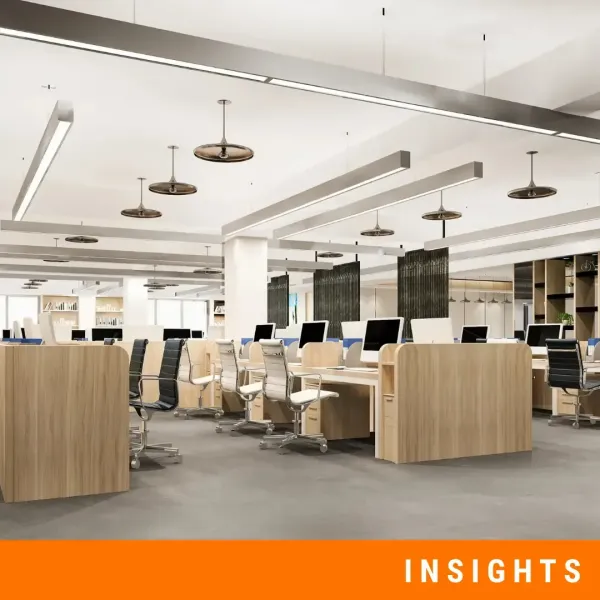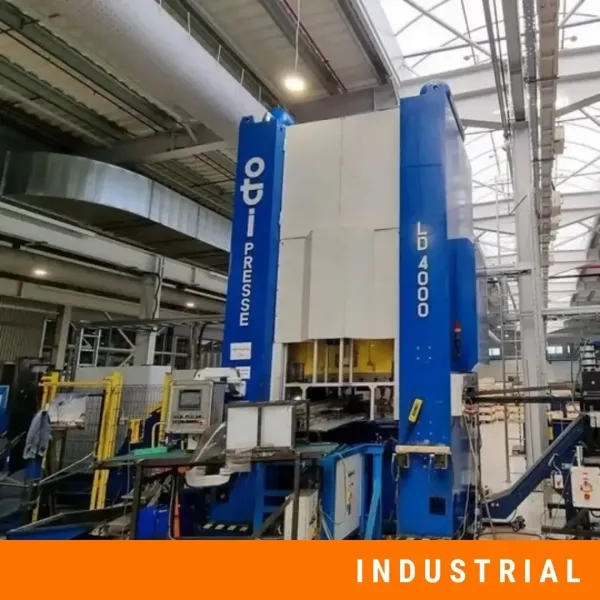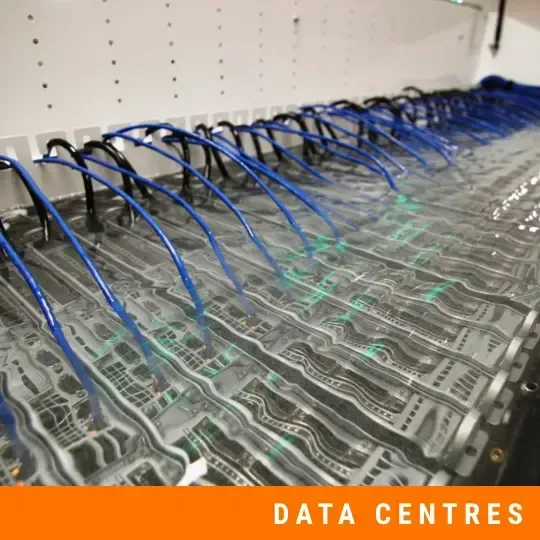Designing Effective Acoustic Enclosures for Industrial Machinery
Sound levels in industrial environments frequently exceed permitted levels due to the continuous operation of heavy equipment such as compressors, chillers, generators, and cutting machines. This equipment often produces sound levels that exceed 85 decibels (A). The dB(A) is a weighted decibel scale that reflects the human ear's sensitivity to various frequencies, making it more useful in assessing how sound is perceived and its potential danger.
Long-term exposure to sound levels above 85 dB(A) is considered dangerous to our hearing. At 90 dB(A), unprotected exposure should not exceed 8 hours per day. The permitted exposure time decreases by half for every 3 dB(A) increase. Noise-Induced Hearing Loss (NIHL) can result from prolonged noise exposure. This is a permanent and irreversible condition brought on by damage to the inner ear's cochlear hair cells.
The physiological effects go beyond hearing. Chronic noise exposure has been scientifically related to higher cortisol levels, increased blood pressure, exhaustion, and a weakened immune system. Noise management is critical in sectors that value operational safety and personnel retention. Installing acoustic enclosures around noise-emitting equipment is one of the simplest and most efficient techniques for lowering harmful exposure at its source.
Regulatory Pressures and Compliance Requirements
Global occupational safety standards impose strict limits on noise exposure in the workplace. These regulations are designed to protect workers’ hearing, enforce safe working conditions, and hold employers accountable. Key frameworks include:
European Union - Under Directive 2003/10/EC, employers must:
- Take action when daily or weekly noise exposure reaches 85 dB(A).
- Make sure exposure never exceeds 87 dB(A) after accounting for hearing protection.
- Implement measures such as soundproofing, isolation, or scheduling controls once these thresholds are reached.
United Kingdom - According to the Control of Noise at Work Regulations, aligned with EU law:
- Lower exposure action value: 80 dB(A).
- Upper exposure action value: 85 dB(A) - employers must reduce exposure or provide PPE.
- Exposure limit value: 87 dB(A), taking hearing protection into account - must not be exceeded.
United States (Occupational Safety and Health Administration) - Under OSHA 29 CFR 1910.95:
- The allowed Exposure Limit (PEL) is 90 dB(A) over an 8-hour shift.
- The action level starts at 85 dB(A) and triggers hearing conservation programs, monitoring, and training.
Failing to meet these standards can result in fines, shutdowns, and long-term reputational damage. More importantly, environmental noise control is increasingly seen as part of a company’s social and regulatory responsibility. Installing properly engineered soundproof enclosures is one of the most effective ways to stay compliant, protect employees, and avoid expensive retrofits later on.
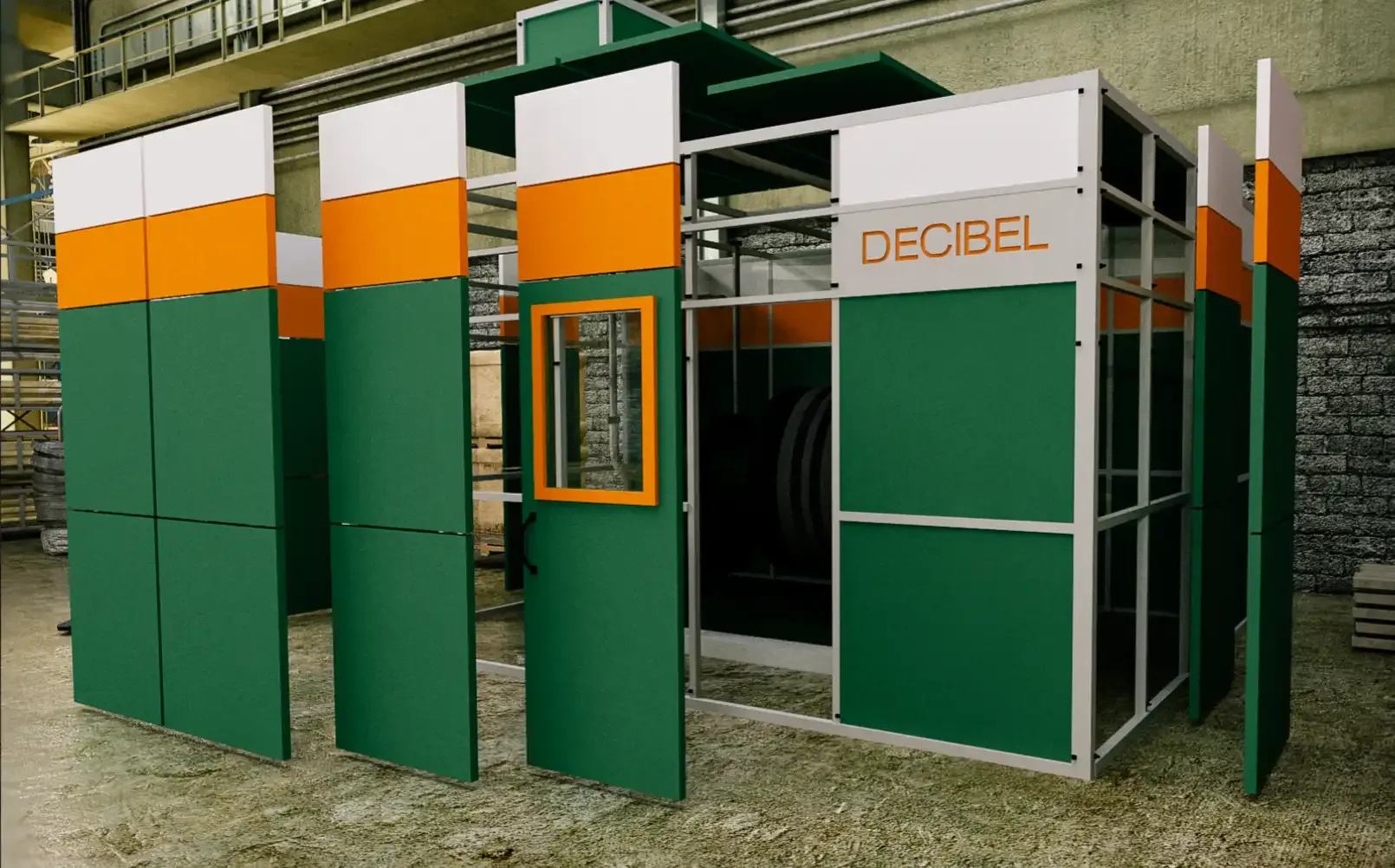
Productivity and Communication Challenges
The acoustic environment directly influences cognitive and operational performance. Excessive background noise impairs speech intelligibility, especially in frequencies between 500 Hz and 4,000 Hz, where people’s communication is most effective and clear. This can cause breakdowns in workflow coordination, especially in high-throughput environments such as assembly lines or CNC machine shops.
The human brain must work harder to filter relevant auditory signals from a noisy background, resulting in quicker mental fatigue. Research published in the Journal of Applied Psychology showed that high ambient noise significantly lowers task accuracy and working memory in industrial settings.
Soundproofing with properly engineered enclosures helps isolate high-decibel sources without harming the workflow. By placing perforated metal panels around machinery or using mobile curtain barriers for flexible setups, facilities can maintain operational efficiency, safety, and compliance at the same time.
Better communication also increases response time during emergencies, making sound management an essential layer in overall risk-solving strategies.
What are the Main Noise Sources and Control Strategies
Designing an efficient acoustic enclosure requires a thorough understanding of the noise sources involved. In industrial settings, not all machines produce noise in the same way, and the primary source may not be obvious at first. Compressors, chillers, transformers, and generators all produce distinct sounds, which are impacted by vibration, air turbulence, mechanical friction, and structure-borne echo.
The very first step is to conduct a noise mapping assessment, which is frequently done with sound level meters or more complex real-time analysers to record overall decibel levels and the entire frequency range of emissions from specific parts of the machine. Absorbent materials, for example, are better at reducing mid-range frequencies above 2,000 Hz. On the other hand, low-frequency noise below 250 Hz, which is frequent in heavy mechanical and rotating equipment, requires mass-heavy barriers and damping methods due to its longer wavelengths and increased energy penetration.
In many cases, the most problematic emissions come from secondary sources, such as vibration transferred through mounting frames or airborne sound leakage through ventilation openings. For this reason, engineers must differentiate between two types of noise.
- Airborne noise - travels directly through openings or thin barriers.
- Structure-borne noise - transmitted through physical contact with floors, walls, or next to equipment.
This distinction drives two different control strategies. Airborne noise is typically reduced using absorptive linings. For example, DECIBEL’s perforated PZP™ panels or DBB soundproofing curtains. On the other hand, structure-borne noise must be controlled at the source through isolation mounts, decoupling joints, and vibration-dampened enclosure framing. Ignoring this distinction often leads to expensive rework, as sometimes visually complete enclosures may still leak unwanted mechanical energy.

At DECIBEL, building an enclosure begins with site-specific acoustic diagnostics. The team of engineers model noise propagation in three dimensions, account for reverberation in surrounding structures, and locate critical leak paths. For example ventilation slots or shared structural supports. This allows the final solution to target both direct emissions and reflected or coupled noise, making sure measurable reductions in dB levels and compliance with workplace standards.
Noise control is about engineering the right interventions at the right points in the system, based on how and where the noise travels.
Choosing the Right Materials for Sound Insulation and Absorption
The performance of any industrial soundproof enclosure is determined by its design and construction, as well as the physical properties of the materials utilised. Effective noise control consists of two major approaches: sound absorption and sound insulation. The most effective enclosures combine the two, using a multilayer material structure customised to the machine's noise profile.
Mineral wool, melamine foam, and high-density polyester are examples of porous, fibrous materials used to absorb sound. These materials work by turning sound energy into heat via internal friction, particularly at mid and high frequencies. In industrial sound enclosures, these absorptive cores are typically put behind perforated surfaces that allow sound waves to pass through while shielding the material from physical damage. DECIBEL's PZP™ perforated steel panels are specifically built in this way. They have a galvanised steel front with precision perforations, which is supported by an interior absorbent layer to reduce airborne noise buildup inside the enclosure.
Absorption, on the other hand, is significantly less efficient against low-frequency noise. Sound below 250 Hz, such as the hum from huge motors or generators, has longer wavelengths and more energy, making it difficult to absorb but easy to transmit. Here, soundproofing is critical. This requires the use of solid, non-porous materials like steel sheets, lead alternatives like mass-loaded vinyl, or composite barrier panels. The idea behind it is simple: according to the mass law in acoustics, every doubling of surface mass results in approximately 6 dB of additional sound transmission loss. In practice, heavier walls reduce noise.
Damping treatments are often incorporated into wall structures to prevent these dense panels from vibrating and becoming secondary sound sources. This can include limited layer damping, which uses viscoelastic materials sandwiched between rigid plates to absorb vibrational energy. For applications involving heavy rotating equipment, this element can have significant effects on total noise performance.
A well-designed enclosure is not based on a single material. Instead, it employs a tiered approach, with mass layers for soundproofing, porous cores for absorption, and damping layers to reduce structural resonance. Each material has a unique role in reducing airborne and structure-borne noise.
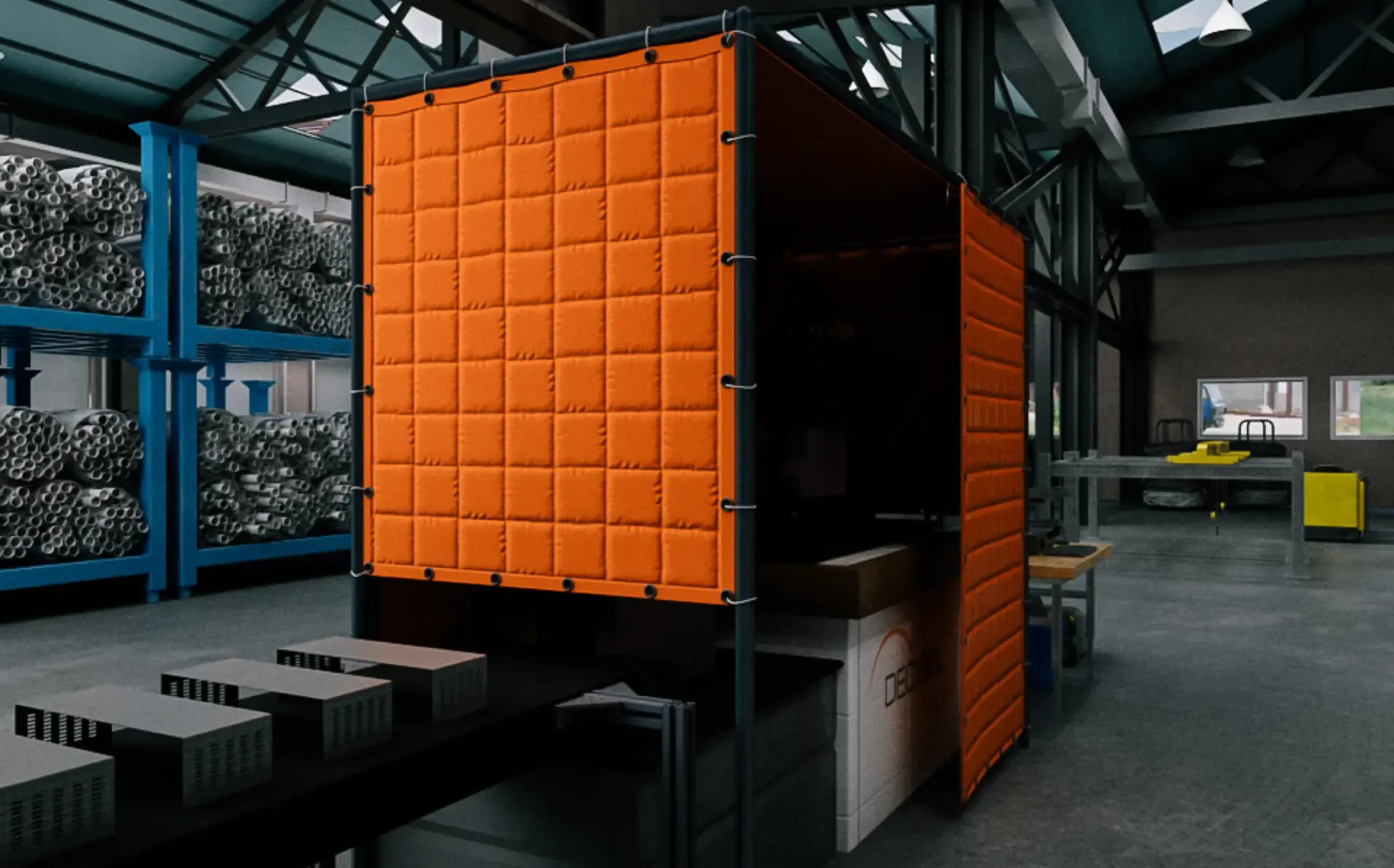
Engineering for Real-World Conditions
Even the most acoustically optimal materials and theoretical designs are ineffective if the enclosure fails in real-world conditions. Industrial soundproofing involves building enclosures that can survive hostile conditions, tolerate vibration, allow operational access, and provide constant noise suppression.
Structural Integrity
Industrial enclosures must be stiff enough to resist deformation, particularly when subjected to high-pressure fans, mechanical shocks, or thermal expansion. Flexible or poorly secured enclosures may develop gaps and resonant modes, significantly reducing their effectiveness. DECIBEL builds all enclosures with reinforced frames and heavy-gauge steel or composite coating to guarantee structural stability and acoustic performance over time.
Vibration Isolation
The structure-borne noise can pass directly through physical connections between machines and enclosures. This can get past even the most advanced soundproofing technologies. In order to take care of this, important contact points, such as floor mounts, pipe penetrations, and common structural components, must be separated by anti-vibration mounts, robust gaskets, or floating floor systems. Without these specifics, enclosures can become extensions of the machine, generating noise instead of reducing it.
Ventilation and Access
Many enclosures fail in terms of ventilation and access. Machines require airflow to avoid overheating, and maintenance workers need easy access to service. However, every air entrance, service hatch, or removable panel introduces a possible acoustic weak point. The solution is to install acoustically treated ventilation systems, which often use internally walled ducts with various bends or silencers to reduce noise without reducing the airflow. Doors and panels must be lockable in order to maintain a tight seal during operation. The hinges, latches, and seams must be designed for convenience and to maintain the enclosure's acoustic integrity.
DECIBEL enclosures are created with all these realities in consideration. Doors are strengthened and sealed, ventilation is integrated with tuned silencers, and panels are modular for easy removal while maintaining performance. Outdoor installations incorporate weather-resistant coatings and thermal insulation without compromising the promised noise reduction.
Ensuring Compliance and Long-Term Performance
Soundproof enclosures are only effective if they continue to meet safety standards and noise limits over time. In industrial settings, where excessive noise can lead to hearing damage and legal penalties, a short-term fix or partial solution simply isn't enough.
Most industrial regulations, such as those in the EU and the US, have set strict limits on how much noise workers can be exposed to. They are typically capping it at 85 dB(A) over an 8-hour shift. But it doesn’t stop there. These standards also require companies to take action before that limit is reached and once ambient noise levels start getting close to the it. That means your soundproofing solution needs to keep working even as equipment ages, machines are moved around, or even if new sources of noise are added.
That’s why it is so important to think long-term when making these decisions. Absorptive materials can settle or wear out. Door seals and access panels may loosen over time, allowing sound to leak through gaps. If the enclosure isn’t built with durable materials and engineered details, the performance will drop and with it also your compliance and workplace safety.
To guarantee compliance, facilities must carry out before-and-after noise measurements, ideally incorporating frequency analysis. In some businesses, regular evaluation is required by law, and recorded performance data helps in audits and risk assessments.
As factory layouts change or new machinery is added over time, enclosures need to evolve at the same time. That is why DECIBEL creates modular systems that can be changed or expanded without disassembling everything, which is quite convenient. This reduces long-term costs while helping noise control even in unpredictable situations.
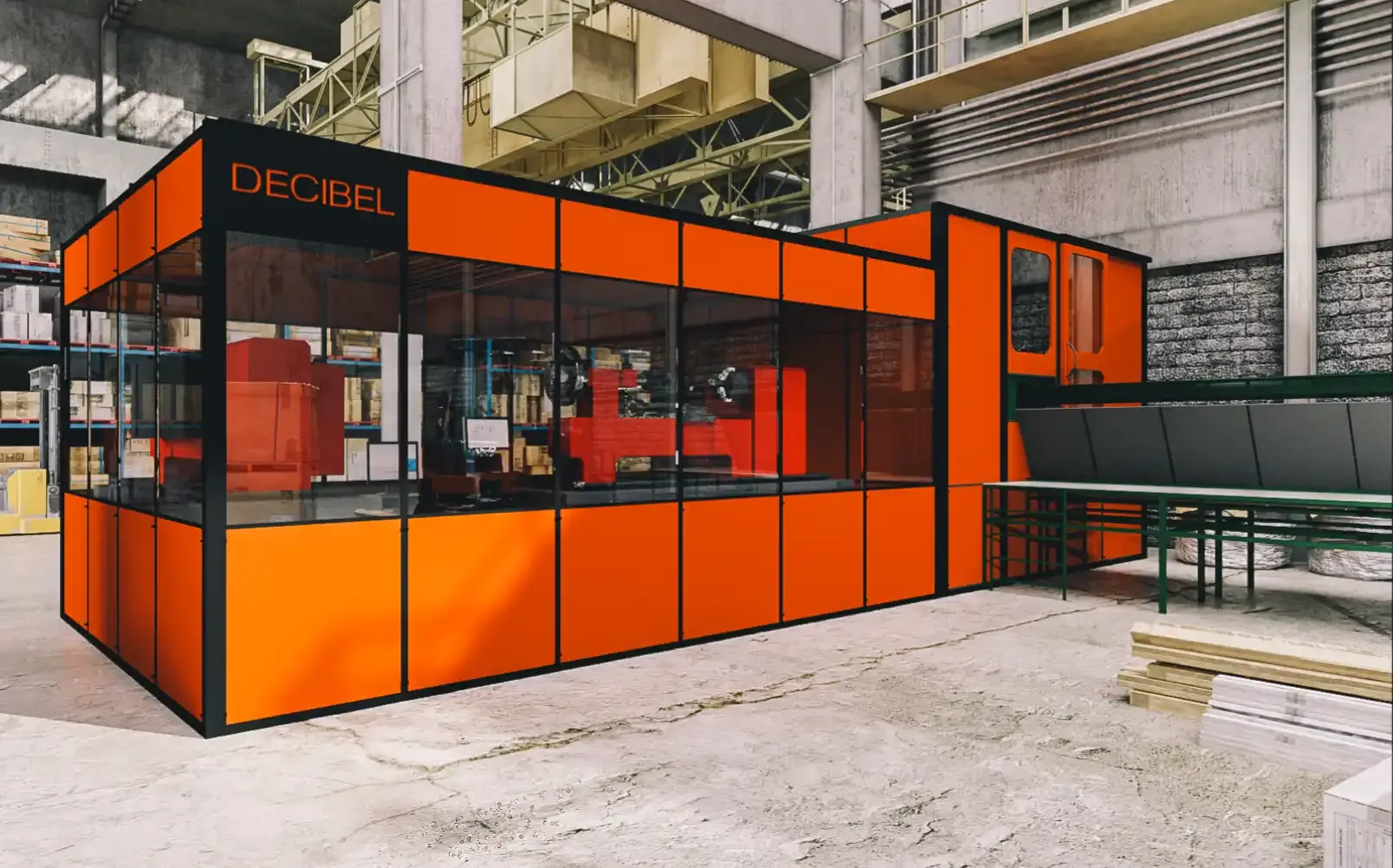
Designing an effective soundproof enclosure takes more than lining walls with insulation. It requires a deep understanding of how noise travels, what materials actually work, and how to build systems that perform reliably under industrial conditions. From protecting workers and meeting legal standards to improving productivity on the floor, proper soundproofing is essential engineering.
Beyond the factory, smart noise control also protects surrounding communities and strengthens a company’s reputation for responsible operation. When done right, a well-built enclosure reduces decibels, risk, downtime, and long-term costs for your company.
If you're planning a new installation or need to upgrade your current noise control setup, our team at DECIBEL is here to help.
Explore custom soundproofing solutions built to meet your exact industrial needs.
